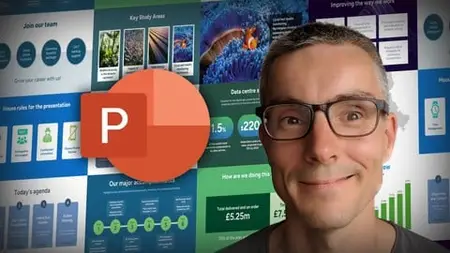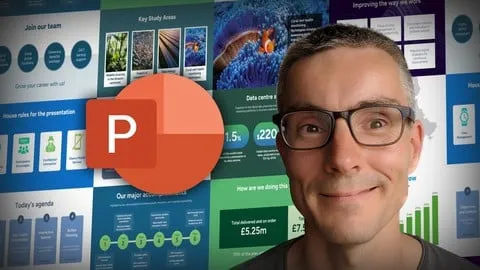Improve Your Powerpoint Design
Published 8/2025
MP4 | Video: h264, 1920x1080 | Audio: AAC, 44.1 KHz
Language: English | Size: 2.56 GB | Duration: 3h 7m
Published 8/2025
MP4 | Video: h264, 1920x1080 | Audio: AAC, 44.1 KHz
Language: English | Size: 2.56 GB | Duration: 3h 7m
How to sharpen your graphic design skills using key principles and persuasive presentation techniques
What you'll learn
Improve your PowerPoint slide design using principles of design and powerful presentation techniques.
How to apply core design principles such as contrast, alignment, hierarchy, balance, and white space to create clear, engaging slides.
How other presentation focussed considerations such as animation, alignment, typography and visualisation can lead to better results.
How to apply this theoretical knowledge to useful slide layouts which will help your communicate ideas with greater clarity and confidence.
Requirements
Microsoft 365 recommended or PowerPoint 2010 / 2013 / 2016 / 2019
Description
In this course, you’ll explore essential design principles and learn how to apply them with clarity and purpose.The principles of design help make better slides by ensuring content is clear, engaging, and visually balanced. They guide how elements are arranged and styled, so slides are easier to understand and more impactful. For example:Contrast highlights key points and improves readability.Hierarchy directs attention to the most important information first.Balance and proximity group related elements logically, reducing visual clutter.Repetition creates consistency, reinforcing your message and brand.Each principle will be explained clearly using example slide designs followed by simple step by step walkthroughs.We'll also cover presentation specific considerations such as:Alignment to keep slides tidy and professional.Using typography to enhance readability and help convey the right tone or personality.How animations can enhance communication and engagement if used thoughtfully.Creating a colour scheme to create effective, professional, and visually appealing presentations.Ways to visualise your content because people understand and engage with visuals far better than with text alone.Together, these principles help audiences focus, follow, and remember your content more effectively.You will then use this knowledge to develop your graphic design skills to build persuasive and visually impactful slide layouts.Using practical examples, you'll see how these principles come to life in everyday design scenarios but asking questions such as:What are they trying to say?What can I simplify?How can I show this better?What grabs my attention?Will the audience remember my message?You'll explore best practices for structuring content, using whitespace effectively, choosing the right visuals, and creating slide decks that tell a compelling story. Techniques covered include converting bullet points to slide layouts using Smart Art, reducing on on screen content to to provide more impact, and grabbing attention with big figures and icons, We'll also show you how to make better tables, charts and maps, create timelines and visualise processes. Finally, we'll cover interaction and animation using the Slide Zoom, Morph Transition, links and highlighting techniques.Whether you're designing a pitch deck, a report, or a campaign presentation, this course will help your communicate ideas with greater clarity and confidence.
Overview
Section 1: Design Principles
Lecture 1 Contrast
Lecture 2 Balance
Lecture 3 Empahsis
Lecture 4 Hierarchy
Lecture 5 Proportion
Lecture 6 Repetition
Lecture 7 Variety/Unity
Lecture 8 Movement
Lecture 9 White Space
Section 2: Presentation Specific Considerations
Lecture 10 Typography
Lecture 11 Colour Schemes
Lecture 12 Alignment
Lecture 13 Animation
Lecture 14 Using The Screen Effectively
Lecture 15 Visualise Your Content
Section 3: Practical Examples
Lecture 16 Convert Bullets To Smart Art
Lecture 17 Use A Coloured Background
Lecture 18 Reduce On Screen Content
Lecture 19 Use Icons For Visual Appeal
Lecture 20 Grab Attention With Big Figures
Lecture 21 Use A Map For Geographic Data
Lecture 22 Using Logos To Make A Slide More Visual
Lecture 23 Using Questions To Engage The Audience
Lecture 24 Using Screen Space Effectively
Lecture 25 Create A Basic Infographic
Lecture 26 Visualise A Process
Lecture 27 Show Relative Values With Shapes
Lecture 28 Highlighting With Animation
Lecture 29 Engage With Well-Chosen Images
Lecture 30 Make Better Tables
Lecture 31 Enhance Bar Charts For More Clarity
Lecture 32 Using A Linear Timeline
Lecture 33 Add Interactivity With Slide Zoom
Lecture 34 Using A Journey Map
Lecture 35 Using Links For Interaction And Audience Participation
Professionals and business presenters who want to improve the clarity and impact of their slides.,Students and educators seeking to create more engaging and effective presentations.,Design beginners who want practical, easy-to-apply guidance on slide layout and visual communication.,Marketing, sales, and training teams who regularly build decks for clients or internal stakeholders.,Anyone frustrated with dull or cluttered slides and looking for simple, repeatable techniques to improve them fast.



